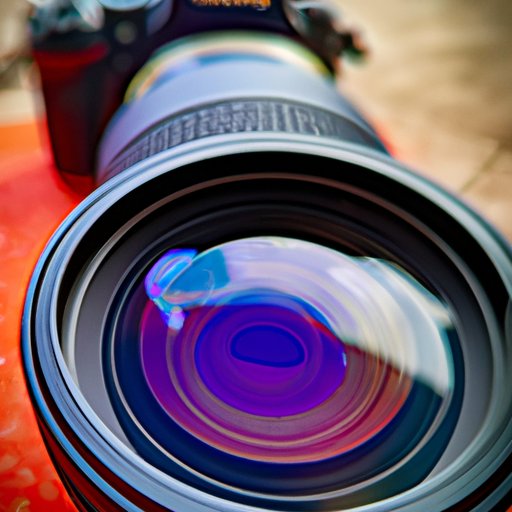Introduction
Sharpness is an important aspect of photography that helps to bring out the best in your photos. It is a measure of the clarity and detail of an image, and can be used to create stunning visuals with great impact. In this article, we will explore what sharpness is in photography, its purpose, and how to achieve maximum sharpness in your photos. We will also discuss the role of aperture and shutter speed, lens types, focus techniques, and tools for increasing visual impact with sharpness.

Exploring the Basics of Sharpness in Photography
Sharpness in photography is measured by the clarity and detail of an image. It is determined by several factors, such as the quality of the lens, the camera settings, and the lighting conditions. The purpose of sharpness is to create images that are clear and detailed, with good contrast and color saturation. When shooting, it is important to ensure that all of these factors are taken into account in order to achieve the best results.

How to Achieve Maximum Sharpness in Your Photos
Achieving maximum sharpness in your photos requires understanding the basics of aperture, shutter speed, lens types, and focus techniques. Aperture is the size of the opening in the lens, which affects the amount of light that passes through to the image sensor. Shutter speed is the time that the shutter is open, which determines the amount of motion blur in the image. Understanding these two elements is essential for capturing sharp images.
In addition to understanding aperture and shutter speed, it is important to consider the type of lens you are using. Different lenses have different characteristics and produce different results. Prime lenses, zoom lenses, and macro lenses are all available, and each has its own advantages and disadvantages. It is important to choose the right lens for the type of photography you are doing in order to get the best results.
Tips for Achieving Sharp Focus in Photography
Once you understand the basics of aperture and shutter speed, there are several techniques you can use to ensure sharp focus in your photos. Manual focus techniques, such as focusing on a specific point or area, can be used to ensure that the subject is in focus. Autofocus techniques, such as using autofocus points or face detection, can also be used to help keep the subject in focus.
Choosing the right lens is also important for achieving sharp focus. Prime lenses, which have fixed focal lengths, are often used for portrait and landscape photography, while zoom lenses are better suited for sports and wildlife photography. Macro lenses are great for close-up photography, and can be used to capture incredibly detailed images.
What You Need to Know About Achieving Sharpness in Photography
In addition to understanding aperture and shutter speed, and choosing the right lens, there are several other factors that can affect the sharpness of your photos. Image stabilization technology can be used to reduce camera shake and blur, while using a tripod can help to keep the camera steady and prevent motion blur. Lighting is also important, as too much or too little can cause blurriness.

The Role of Aperture and Shutter Speed in Achieving Sharpness
Aperture and shutter speed play an important role in achieving sharpness in your photos. Aperture is the size of the opening in the lens, which affects the amount of light that passes through to the image sensor. The larger the aperture, the more light that will pass through, resulting in a brighter image. The smaller the aperture, the less light that will pass through, resulting in a darker image.
Shutter speed is the time that the shutter is open, which affects the amount of motion blur in the image. Slower shutter speeds allow more light to enter the camera and can be used to capture moving objects, while faster shutter speeds allow less light to enter the camera and can be used to freeze motion. Understanding how aperture and shutter speed work together is essential for capturing sharp images.

An Overview of Lens Types for Producing Sharp Photos
When it comes to producing sharp photos, different lens types can be used to achieve different results. Prime lenses, which have fixed focal lengths, are often used for portrait and landscape photography, while zoom lenses are better suited for sports and wildlife photography. Macro lenses are great for close-up photography, and can be used to capture incredibly detailed images.
Techniques for Increasing Visual Impact with Sharpness in Photography
Sharpness can be used to create stunning visuals with great impact. Using depth of field can help to separate the subject from the background, while panning shots can be used to create motion blur around the subject. Post-processing can also be used to enhance the sharpness of an image, and to adjust contrast, saturation, and other elements to create the desired effect.
Conclusion
Sharpness is an important element of photography that can be used to create stunning visuals with great impact. In this article, we discussed the basics of sharpness in photography, how to achieve maximum sharpness with aperture, shutter speed, lens types, and focus techniques, and tips for increasing visual impact with sharpness. By understanding the basics of sharpness, and the role of aperture and shutter speed, you can create beautiful, sharp photos that will stand out from the crowd.
(Note: Is this article not meeting your expectations? Do you have knowledge or insights to share? Unlock new opportunities and expand your reach by joining our authors team. Click Registration to join us and share your expertise with our readers.)
